Although most colleges and universities have established IT governance practices, the approaches differ, with varying levels of effectiveness.

EDUCAUSE is helping institutional leaders, IT professionals, and other staff address their pressing challenges by sharing existing data and gathering new data from the higher education community. This report is based on an EDUCAUSE QuickPoll. QuickPolls enable us to rapidly gather, analyze, and share input from our community about specific emerging topics.Footnote1
For the purposes of this QuickPoll survey, we used the following definition of "IT governance":
IT governance refers to programs or processes that ensure the effective and efficient use of IT in enabling an institution to achieve its strategic objectives.
The Challenge
Following a dramatic shift in how institutions manage their work and workforce over the past few years, our first QuickPoll of 2024 sought to capture a snapshot of the current state of higher education IT governance to help answer some of the most pressing questions currently being posed by IT leaders in this space: What are the most critical components of successful higher education IT governance? How can IT units further elevate the position of IT governance to be an effective strategic function aligned with the institution's operational framework? And, where do we go from here?
The Bottom Line
While most respondents reported that their institutions currently have established IT governance, institutions are using several different approaches to structure their IT governance body/bodies (assigned leader[s], stakeholder involvement, decision-making authority), as well as how they manage IT governance (formally or informally), some of which are more effective than others. With the onslaught of changes the pandemic thrust upon higher education, institutions would be expected to have adjusted or evolved how IT governance is defined in the context of their institutions. It appears they are doing just that.
The Data: State of IT Governance in Higher Education
IT governance is just as relevant today as it was a decade ago, even though it has lagged behind other strategic efforts. Nearly two-thirds of respondents (64%) reported their institutions currently have established IT governance, and 72% of respondents reported their institutions have established institutional governance (see figure 1).
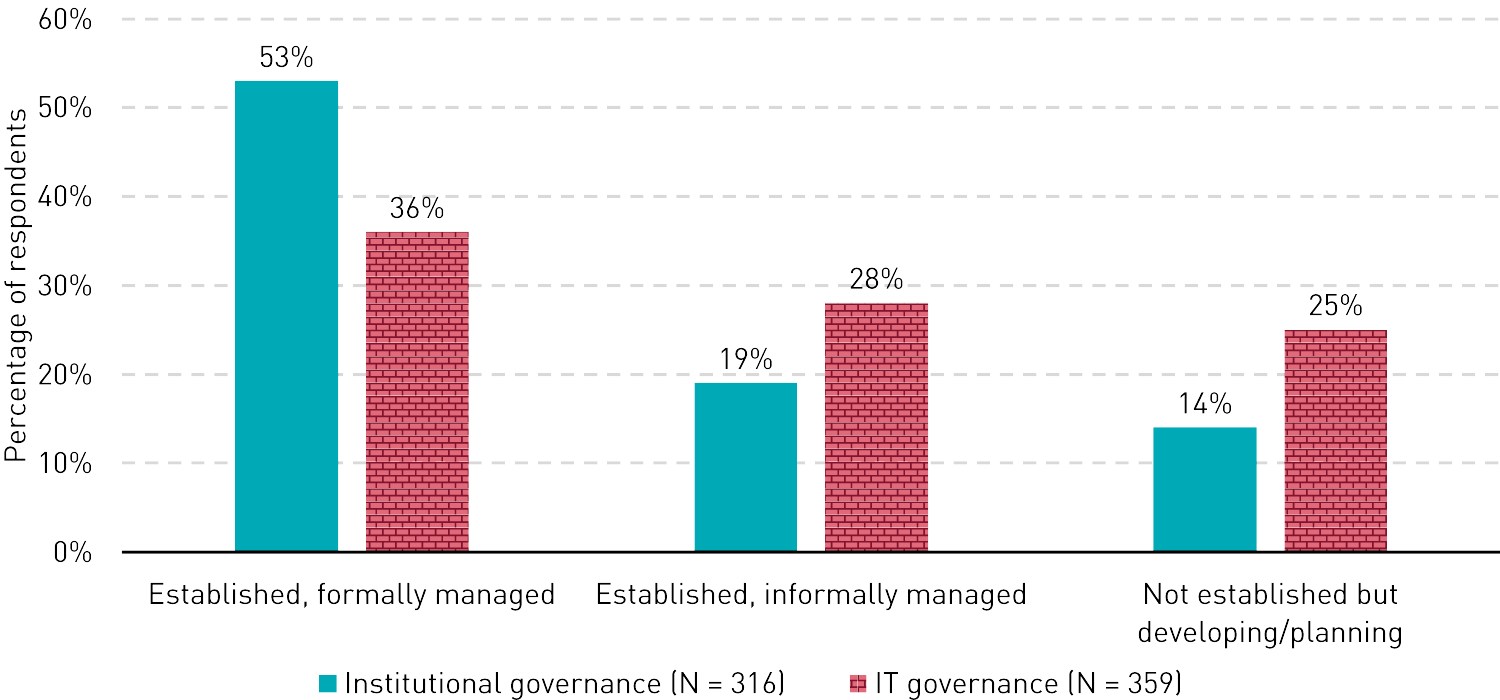
Nearly half of respondents agreed or strongly agreed that IT governance in higher education has "changed dramatically" over the past 10 years (49%) and has "improved overall" (48%). That said, a majority reported that IT governance has lagged behind other strategic efforts over the past 10 years (66% agreed or strongly agreed; see figure 2), a perception that might reflect the lack of formality with which institutions are managing their established IT governance (36% formally managed).
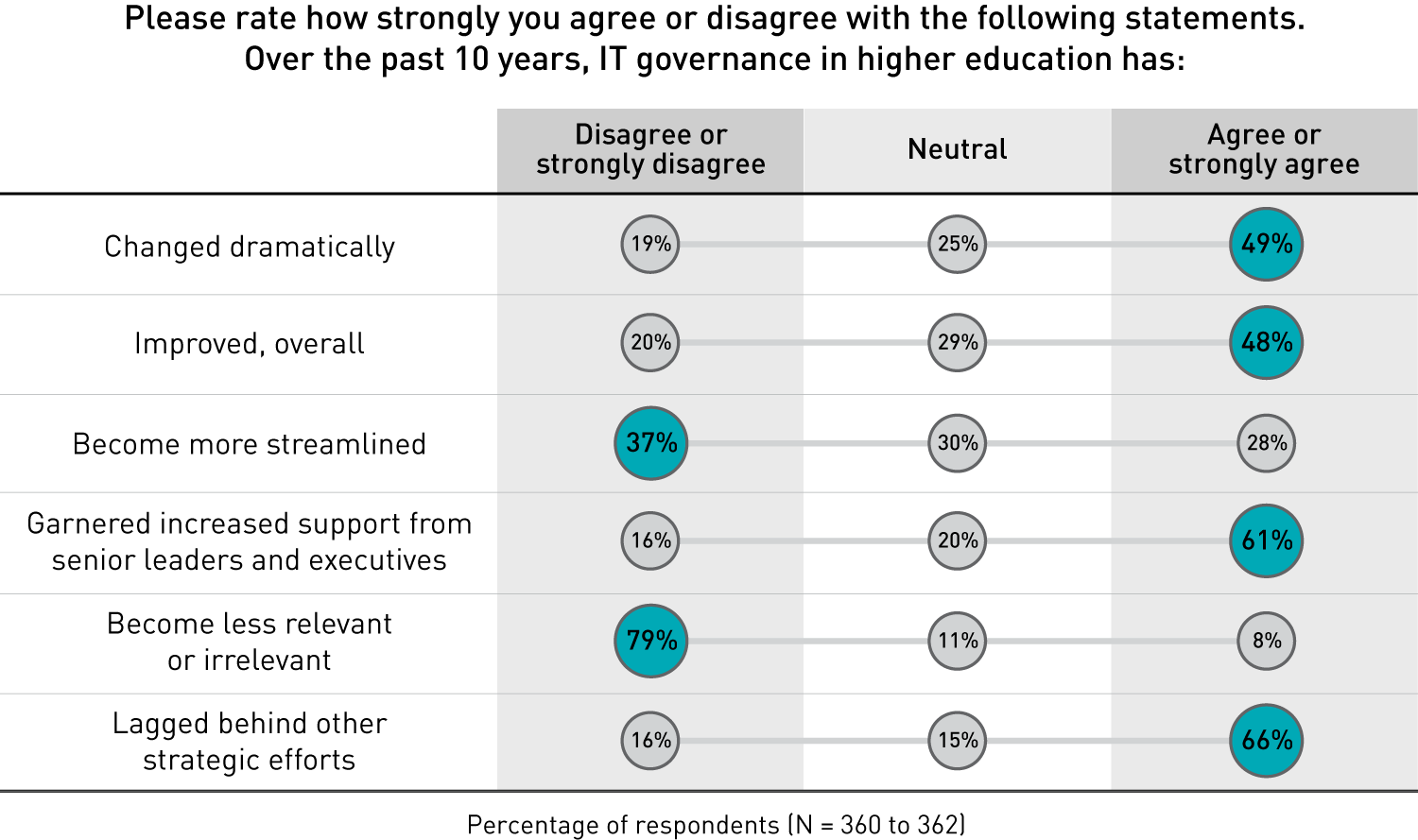
IT governance may have lagged behind other strategic efforts, but the improvements are evident. Respondents who agreed or strongly agreed that IT governance has improved overall were asked in an open-ended question to identify the ways in which it has improved. Among the 138 responses received, respondents reported that improvements were aligned to the four areas below.
Heightened stakeholder awareness, understanding, and support of IT governance and the value of IT (40%):
"COVID highlighted how critical and strategic IT is to a campus; IT governance was brought to the forefront to aid in strategic decision-making."
Better alignment of IT strategy with overall institutional strategy, strategic priorities, and other strategic functions (28%):
"Making better decisions in partnership with senior leaders across the university. IT has become less of a cost center, and more of a 'value' center."
Availability of IT governance frameworks, improved processes and structures (25%):
"There has been consolidation of policies, procedures, and resources from splintered units into more streamlined, cost-effective centralized resources, as well as far more frequent single sources of truth where policy and procedure is concerned, rather than conflicting information and approaches contained within unit silos."
Increase in leadership engagement and recognition of the need for IT governance (22%):
"IT has been accepted as a strategic enabler and therefore is getting more attention by senior leaders."
The Data: Structure and Scope of Institutional IT governance
IT governance is primarily led by CIOs, along with leaders of IT. A strong majority (72%) of respondents whose institutions have established IT governance identified the CIO or equivalent as one of the positions leading their institutions' IT governance. Respondents also identified other IT director/manager (21%), deputy CIO or equivalent (20%), and CISO or equivalent (17%) as leaders of IT governance. This finding may indicate that institutions are framing IT units' scope of management around IT governance to be more aligned with the functions within IT.
Strategic responsibilities are becoming more common for IT governance bodies. At institutions that currently have or are in the process of establishing IT governance, a number of strategic activities commonly fall within the scope of IT governance, including aligning IT/technology strategy with institutional strategy (72%) establishing or maintaining policies (71%), and approving the institution's IT/technology strategy (65%). Somewhat fewer IT governance bodies are responsible for advising on service improvement priorities (54%) and service levels (39%); 6% reported "other" responsibilities, including accessibility, advising on IT success metrics, change management, compliance, and procurement (see figure 3).
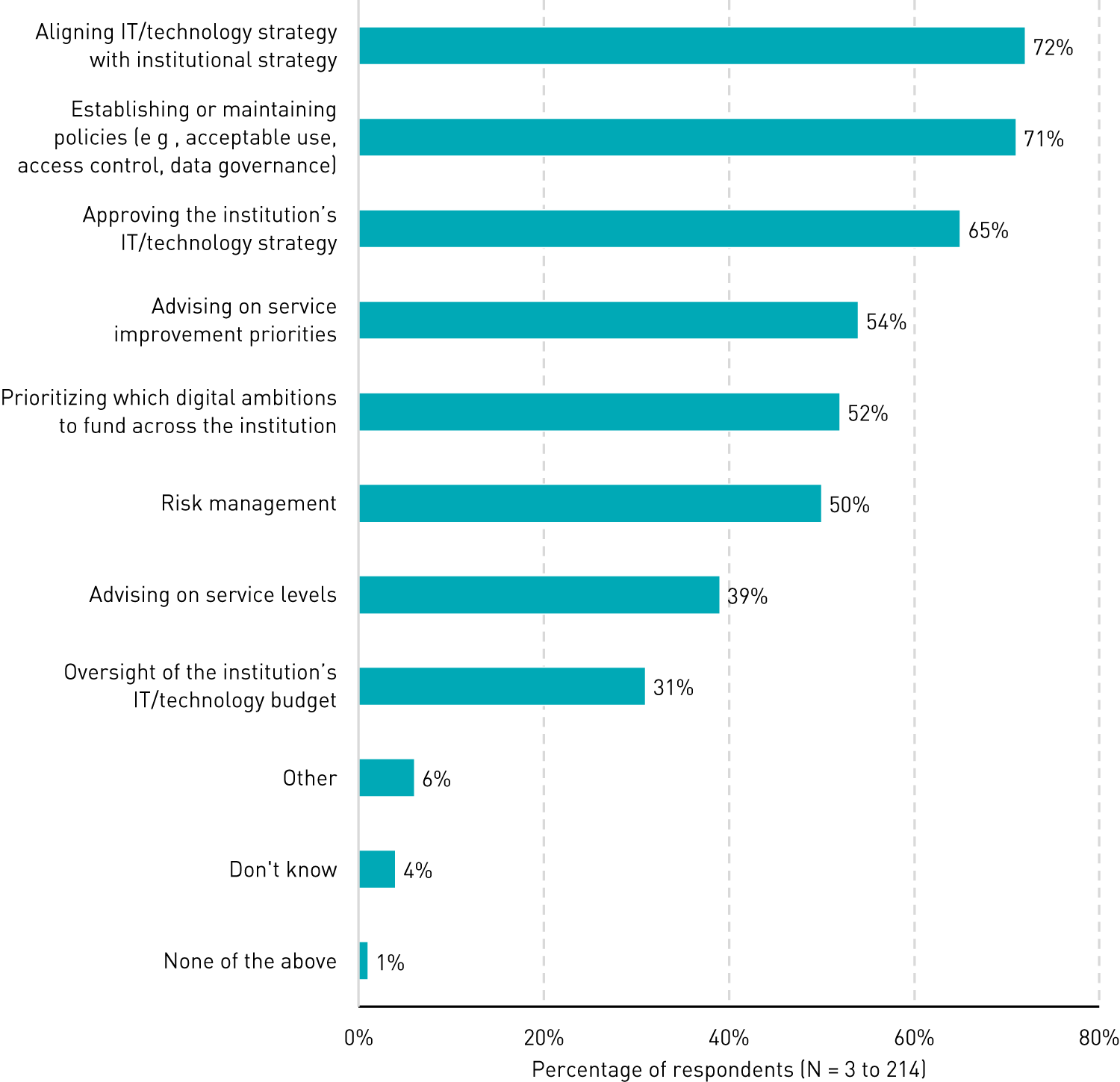
Most IT governance bodies recommend but don't decide. Slightly more than one-third of respondents whose institutions have established IT governance or are developing or planning to implement IT governance indicated that the IT governance body is or will be expected and empowered to make relevant and/or important decisions (35%), while 51% of respondents reported that their IT governance body is or will be tasked with making recommendations to inform final decisions made by others (see figure 4).
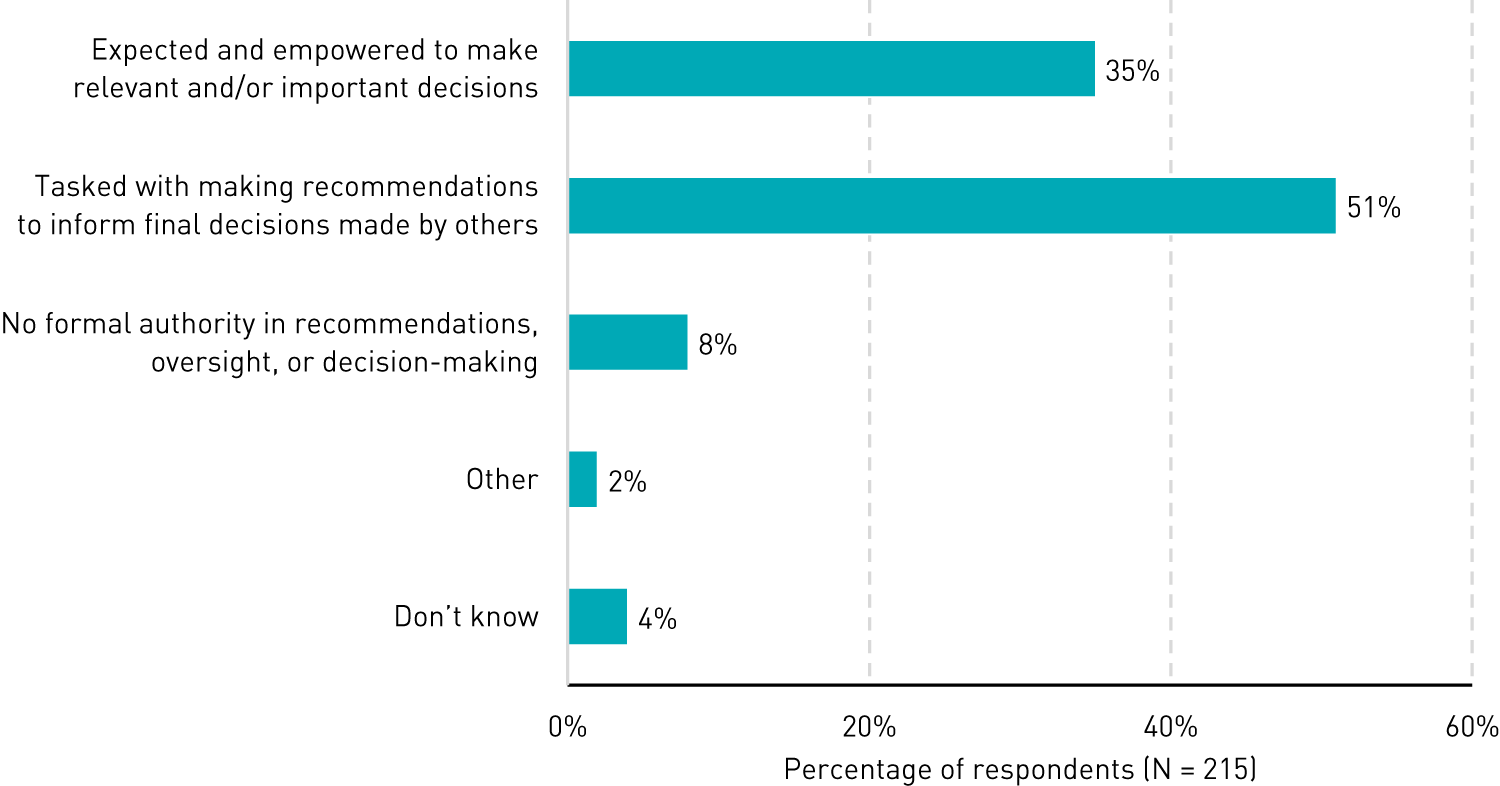
Respondents who selected "other" described various kinds of authority, including a mix of making decisions in some cases and making recommendations in others; approving recommendations made by other groups; and standing committees that make decisions and advisory committees that make recommendations and provide insight. Interestingly, respondents whose IT governance body is expected and empowered to make relevant and/or important decisions rated the effectiveness of their institutions' IT governance more favorably (58% effective/extremely effective) than those whose IT governance bodies are tasked with making recommendations to inform final decisions made by others (32% effective/extremely effective).
The Data: Stakeholder Involvement
Respondents whose institutions have established IT governance or are developing or planning to implement IT governance were asked to select the roles in which they and other stakeholders serve in support of their institutions' IT governance processes:
- Decision-maker: Has a say in relevant and/or important decisions
- Integral contributor: Actively contributes to decisions, not a decision-maker
- Ad hoc collaborator: Consults and collaborates and has no direct say on decisions
Self-identifying the role in which they serve, respondents were split among "decision-maker" (38%), "integral contributor" (32%), and "ad hoc collaborator" (21%). Fewer respondents indicated that they either serve in another capacity (5%) or are not involved in IT governance (4%). Most senior leaders (executive/VP/SVP, C-level officer, president or chancellor) said they are decision-makers (87%), while non-senior leaders mostly identified as integral contributors (46%) or ad hoc collaborators (30%).
Students are minimally involved, faculty and staff contribute, and senior leaders decide. A plurality of respondents (39%) whose institutions' have or are preparing to establish IT governance reported that students are not (or will not be) involved in their institutions' IT governance, while 35% said students serve in an "ad hoc collaborator" role and 23% said students are "integral contributors." Just 6% indicated that students serve as a "decision-maker" in support of IT governance (see figure 5). Majorities of respondents identified non-IT managers or directors (69%) and non-IT professional staff (60%) as "integral contributors," and faculty are mostly split between "integral contributors" (45%) and "ad hoc collaborators" (44%).
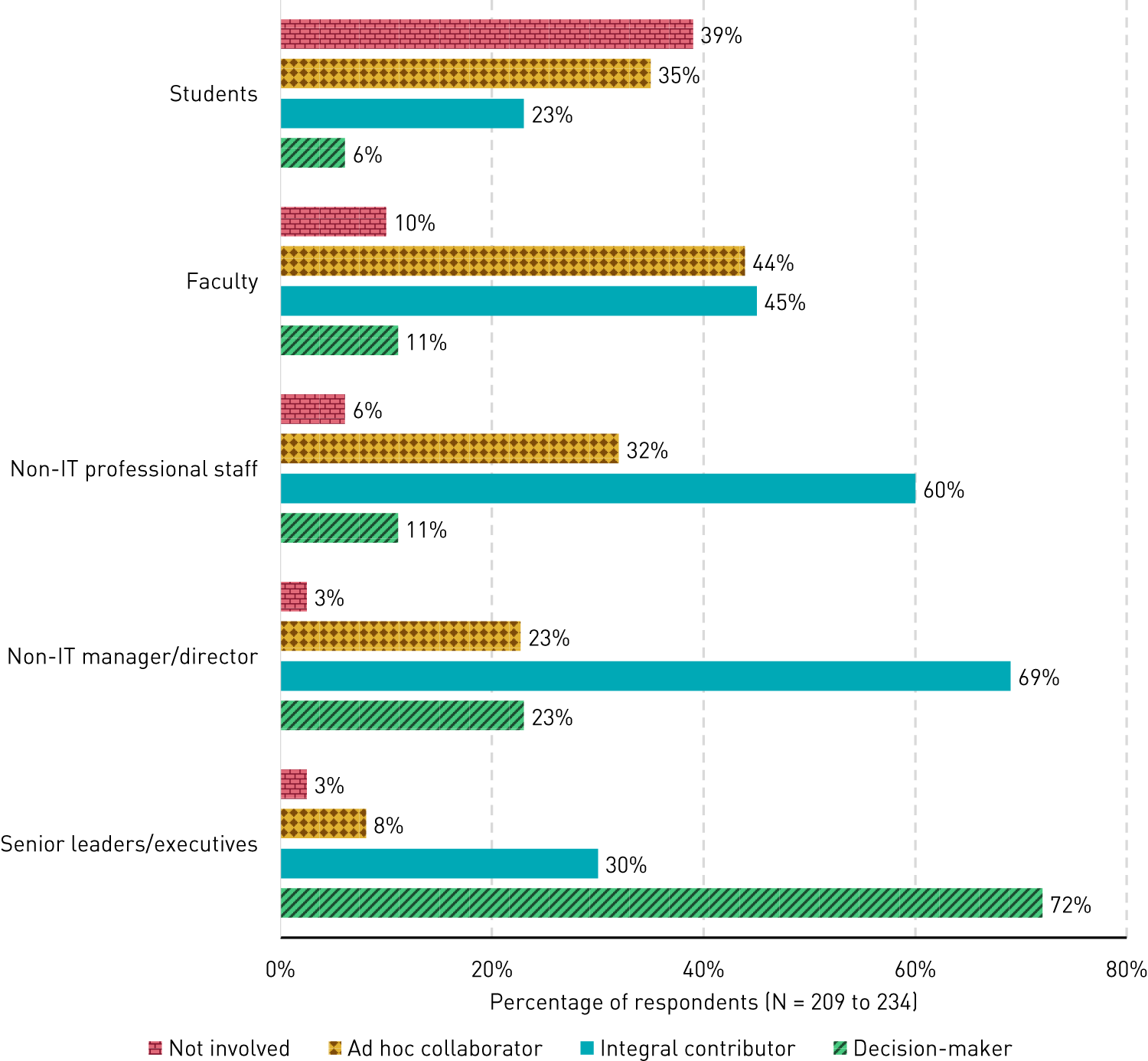
Leadership involvement and support are not the same but should be aligned. A strong majority of senior leaders whose institutions' have or are planning to establish IT governance feel their current involvement in IT governance is sufficient (83%). Senior leaders who would prefer to increase their involvement cited several factors that limit their current involvement: the volume of competing strategic priorities, time constraints, and ineffective IT governance structures or processes.
Faculty, academic leadership, professional/staff, and managers/directors (i.e., non-senior leaders) whose institutions' have or are preparing to establish IT governance were asked if they feel senior leaders and executives fully support IT governance to the best of their abilities. Although 54% affirmed this sentiment, 31% said no (15% indicated they did not know).
The Data: Reimagining IT Governance as a Vital Strategic Function
Formal IT governance and decision-making governing bodies are perceived to be more effective. Among respondents whose institutions have established IT governance, 53% rated their institutions' IT governance as somewhat effective, 6% said not at all effective, and 39% said effective or extremely effective (see table 1). Twice as many respondents whose institutions formally manage IT governance rated IT governance as effective or extremely effective than those who do not formally manage IT governance (50% and 24%, respectively). Likewise, far more respondents whose IT governance bodies are expected and empowered to make relevant and/or important decisions rated IT governance as effective or extremely effective than those whose institutions employ other models.
|
|
Not at All Effective | Somewhat Effective | Effective/ Extremely Effective |
|---|---|---|---|
| Overall |
6% |
53% |
39% |
| Approach to Managing IT Governance | |||
| Established and formally managed |
3% |
44% |
50% |
| Established, not formally managed |
10% |
65% |
24% |
| Structure of IT Governance Body | |||
| Expected and empowered to make relevant and/or important decisions |
1% |
39% |
58% |
| Tasked with making recommendations to inform final decisions made by others |
10% |
57% |
32% |
| No formal authority in recommendations, oversight, or decision-making |
0% |
78% |
17% |
Successful higher education IT governance is strategically designed to enable support and better position the value-add of IT governance. In an open-ended question, respondents were asked to identify the most critical components to successful IT governance in higher education. Responses from 356 respondents were analyzed and coded, falling primarily within three themes: strategic components of IT governance, attributes for IT governance models, and areas of focus for IT governance bodies (8% of responses were categorized as "other").
Across the three themes, the top five critical components of higher education IT governance are as follows (see table 2):
- Strategic vision, planning, alignment (36%)
- Stakeholder awareness and understanding, involvement and representation (36%)
- Leadership engagement, support, and partnership (IT and non-IT) (30%)
- Clear, timely, institution-wide communication (27%)
- Clear documentation (policies, processes, and responsibilities) (19%)
| Component | Percentage |
|---|---|
| Strategic Elements of IT Governance (for clearly understood goals and priorities) | |
| Strategic vision, planning, alignment (expanded in figure 6) | 36% |
| Stakeholder awareness, understanding, involvement, and representation | 36% |
| Leadership engagement, support, partnership (IT and non-IT) | 30% |
| Collaboration and cross-functional relationships and network | 17% |
| Formal structure, framework (advisory body, performance metrics) | 12% |
| Decision-making authority (balanced span of control) | 10% |
| Adaptability, agility, and change management | 7% |
| Dedicated and sustainable IT governance resources (financial, staff) | 6% |
| Attributes for IT Governance Models (to enable support for IT governance) | |
| Clear, timely, institution-wide communication | 27% |
| Transparency | 12% |
| Healthy campus culture (respect, credibility, trust, listening, curiosity) | 8% |
| Accountability, enforcement, or follow-through of IT governance | 8% |
| Consistency (expanded in figure 6) | 7% |
| Areas of Focus for IT Governance Bodies (to best position the value-add of IT governance) | |
| Clear documentation (policies, processes, and responsibilities) | 19% |
| Evaluation, prioritization of projects | 8% |
| Data governance (expanded in figure 6) | 8% |
| Security/cybersecurity | 6% |
| Budget management (cost containment, ratio of IT spend to value realization) | 5% |
| Training/education (including IT governance literacy) | 5% |
Taking a deeper look at the components critical for successful IT governance, respondents provided details on those components. Figure 6 shows specific areas that were consistently reported by respondents within each theme.
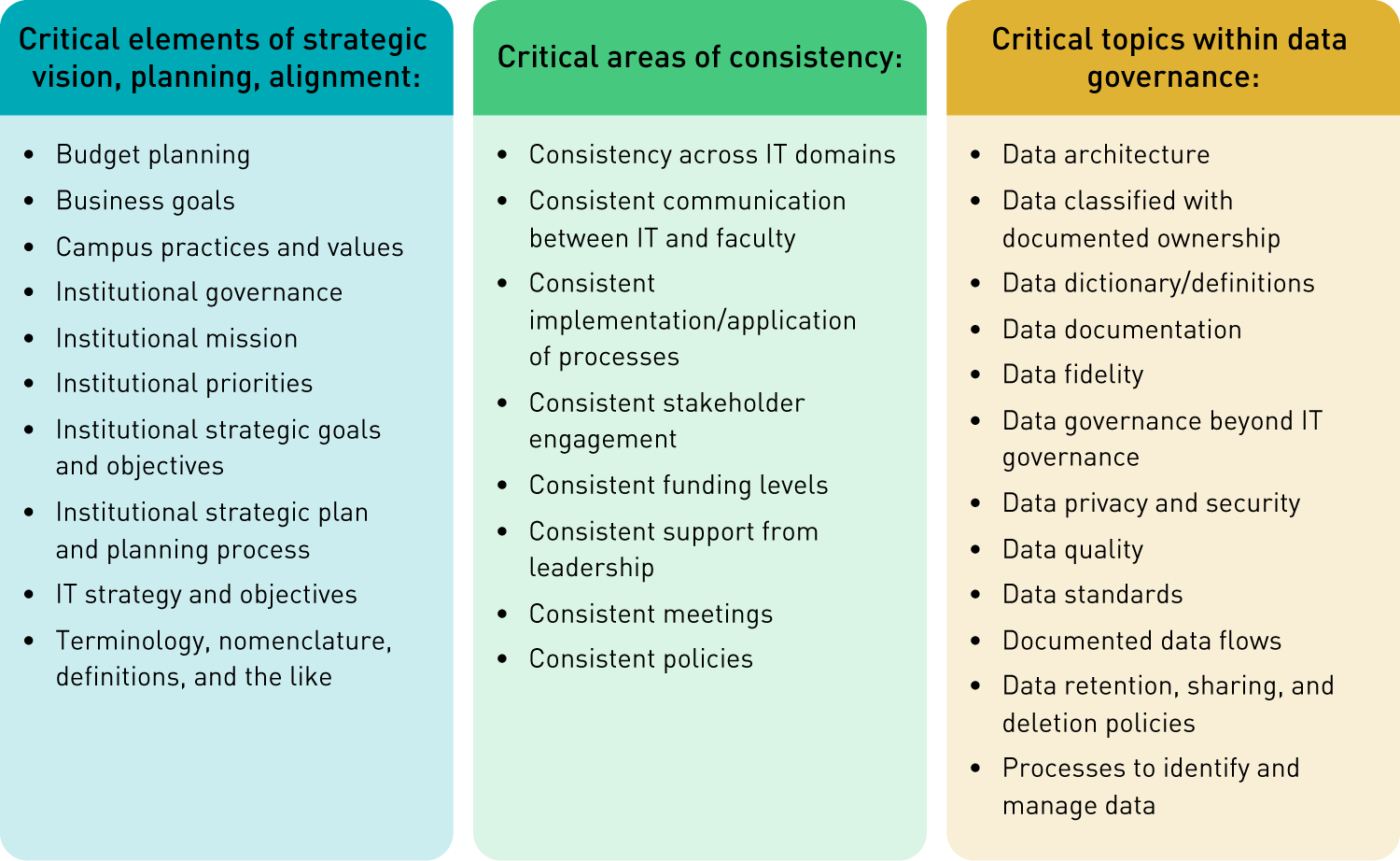
Common Challenges
Misalignment between strategic functions may be more prevalent than you think. Even as more institutions are tasking their IT governance bodies with strategy-aligned work, fewer are empowering those same bodies to make decisions. Higher education institutions and their IT leaders should consider how IT governance processes align with their institutional governance and operational excellence models in order for IT governance to be well positioned to effectively and efficiently enable these and other strategic functions.
Institutions should strategically approach how they manage and structure IT governance. Respondents from institutions that formally manage IT governance, as well as those that expect and empower their governing bodies to make decisions, rated the effectiveness of their institutions' IT governance more favorably than those who employ other approaches to IT governance. As higher education continues to redefine what IT governance looks like, institutions will need to consider institutional context and the extent to which IT governance is aligned with strategic planning and other strategic functions. They might want to explore the extent to which the work environment enables successful IT governance, including the value-add of the work itself.
Promising Practices
The disconnect between governance bodies and decision-makers isn't deeply ingrained (yet). Institutions have an opportunity to bridge the perceived efficacy gap between non-senior leaders who are actively contributing to and/or collaborating on IT governance and the senior leaders who primarily serve as and constitute a majority of IT governance decision-makers. Non-senior leaders are seeking the authority needed to effectuate change through IT governance, and institutions have an opportunity to evaluate whether their current decision-making structure adequately supports their IT governance efforts.
Increased collaboration and cross-functional relationships are key to successful IT governance. For IT governance to be clearly understood, fully supported, and well positioned, institutional leaders within and outside IT will need to strengthen their strategic partnerships with IT units to demonstrate the value of IT governance to stakeholders. Successful IT governance should be grounded in clearly understood goals and priorities—and in critical cultural attributes that enable support for IT governance—to ensure IT governance is well positioned to demonstrate the value it can add.
All QuickPoll results can be found on the EDUCAUSE QuickPolls web page. For more information and analysis about higher education IT research and data, please visit the EDUCAUSE Review EDUCAUSE Research Notes topic channel, as well as the EDUCAUSE Research web page.
Note
- QuickPolls are less formal than EDUCAUSE survey research. They gather data in a single day instead of over several weeks and allow timely reporting of current issues. This poll was conducted Feb. 12–14, 2024, consisted of 23 questions, and resulted in 371 responses. The poll was distributed by EDUCAUSE staff to EDUCAUSE members via relevant EDUCAUSE Community Groups. We are not able to associate responses with specific institutions. Our sample represents a range of institution types and FTE sizes. Jump back to footnote 1 in the text.
Ashley Caron is Researcher at EDUCAUSE.
© 2024 Ashley Caron. The content of this work is licensed under a Creative Commons BY-NC-ND 4.0 International License.
